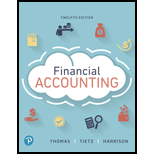
Financial Accounting (12th Edition) (What's New in Accounting)
12th Edition
ISBN: 9780134725987
Author: C. William Thomas, Wendy M. Tietz, Walter T. Harrison Jr.
Publisher: PEARSON
expand_more
expand_more
format_list_bulleted
Concept explainers
Textbook Question
Chapter 6, Problem 6.50Q
In a period of rising prices,
a. cost of goods sold under LIFO will be less than under FIFO.
b. gross profit under FIFO will be higher than under LIFO.
c. LIFO inventory will be greater than FIFO inventory.
d. net income under LIFO will be higher than under FIFO.
Expert Solution & Answer
Want to see the full answer?
Check out a sample textbook solution
Students have asked these similar questions
What are the differences between IFRS and GAAP?
What are the smiliarities between IFRS and GAAP?
please answer part d. include rates for amortization and MACRS.
General Accounting question
Chapter 6 Solutions
Financial Accounting (12th Edition) (What's New in Accounting)
Ch. 6 - Ravenna Candles recently purchased candleholders...Ch. 6 - Which inventory system maintains a running record...Ch. 6 - How is cost of goods sold classified in the...Ch. 6 - Snyders total cost of goods available for sale...Ch. 6 - Snyders cost of goods sold using the average-cost...Ch. 6 - Snyders ending inventory using the FIFO method...Ch. 6 - Snyders cost of goods sold using the LIFO method...Ch. 6 - Which U.S. GAAP principle or rule would apply if...Ch. 6 - Corrigan Corporation had beginning inventory of...Ch. 6 - Corrigans gross profit for the period is a.79,000....
Ch. 6 - What is Corrigans gross profit percentage (rounded...Ch. 6 - Prob. 12QCCh. 6 - A companys beginning inventory is 150,000, its net...Ch. 6 - An understatement of ending inventory by 2 million...Ch. 6 - Prob. 6.1ECCh. 6 - LO 1 (Learning Objective 1: Show how to account...Ch. 6 - LO 1 (Learning Objective 1: Show how to account...Ch. 6 - LO 1 (Learning Objective 1: Show how to account...Ch. 6 - (Learning Objective 2: Apply the average-cost,...Ch. 6 - (Learning Objective 2: Compare income tax effects...Ch. 6 - LO 2 (Learning Objective 2: Apply the average-cost...Ch. 6 - (Learning Objective 2: Apply the FIFO method)...Ch. 6 - (Learning Objective 2: Apply the LIFO method)...Ch. 6 - (Learning Objective 2: Compare income, tax, and...Ch. 6 - LO 3 (Learning Objective 3: Apply the...Ch. 6 - (Learning Objective 4: Compute ratio data to...Ch. 6 - (Learning Objective 5: Estimate ending inventory...Ch. 6 - (Learning Objective 6: Analyze the effect of an...Ch. 6 - Prob. 6.14SCh. 6 - LO 1,2 (Learning Objectives 1, 2: Show how to...Ch. 6 - LO 1,2 (Learning Objectives 1, 2: Show how to...Ch. 6 - LO 2 (Learning Objective 2: Compare ending...Ch. 6 - (Learning Objective 2: Compare the tax advantage...Ch. 6 - Prob. 6.19AECh. 6 - LO 2 (Learning Objective 2: Compare ending...Ch. 6 - LO 2 (Learning Objective 2: Compare gross...Ch. 6 - Prob. 6.22AECh. 6 - LO 5 (Learning Objective 5: Compute cost of goods...Ch. 6 - Prob. 6.24AECh. 6 - LO 4 (Learning Objective 4: Compute and evaluate...Ch. 6 - LO 5 (Learning Objective 5: Use the COGS model to...Ch. 6 - LO 5 (Learning Objective 5: Use the COGS model to...Ch. 6 - LO 6 (Learning Objective 6: Analyze the effect of...Ch. 6 - LO 1, 2 (Learning Objectives 1, 2: Show how to...Ch. 6 - LO 1, 2 (Learning Objectives 1, 2: Show how to...Ch. 6 - LO1, 2 (Learning Objectives 1, 2: Show how to...Ch. 6 - Prob. 6.32BECh. 6 - LO 2 (Learning Objective 2: Apply the average,...Ch. 6 - Prob. 6.34BECh. 6 - Prob. 6.35BECh. 6 - Prob. 6.36BECh. 6 - Prob. 6.37BECh. 6 - Prob. 6.38BECh. 6 - Prob. 6.39BECh. 6 - Prob. 6.40BECh. 6 - Prob. 6.41BECh. 6 - Prob. 6.42BECh. 6 - Prob. 6.43QCh. 6 - Prob. 6.44QCh. 6 - Prob. 6.45QCh. 6 - The word market as used in the lower of cost or...Ch. 6 - Prob. 6.47QCh. 6 - Prob. 6.48QCh. 6 - Prob. 6.49QCh. 6 - In a period of rising prices, a.cost of goods sold...Ch. 6 - Prob. 6.51QCh. 6 - The following data come from the inventory records...Ch. 6 - Prob. 6.53QCh. 6 - Prob. 6.54QCh. 6 - Prob. 6.55QCh. 6 - Prob. 6.56QCh. 6 - Prob. 6.57QCh. 6 - Prob. 6.58QCh. 6 - Prob. 6.59QCh. 6 - LO 1, 2 (Learning Objectives 1, 2: Show how to...Ch. 6 - Prob. 6.61APCh. 6 - LO 2 (Learning Objective 2: Compare inventory by...Ch. 6 - LO 2 (Learning Objective 2: Compare various...Ch. 6 - Prob. 6.64APCh. 6 - (Learning Objective 4: Compute and evaluate gross...Ch. 6 - LO 4, 5 (Learning Objectives 4, 5: Compute gross...Ch. 6 - Prob. 6.67APCh. 6 - Prob. 6.68APCh. 6 - Prob. 6.69BPCh. 6 - LO 2 (Learning Objective 2: Apply various...Ch. 6 - Prob. 6.71BPCh. 6 - LO 2 (Learning Objective 2: Compare various...Ch. 6 - LO 3 (Learning Objective 3: Explain GAAP and apply...Ch. 6 - Prob. 6.74BPCh. 6 - Prob. 6.75BPCh. 6 - LO 5 (Learning Objective 5: Use the COGS model to...Ch. 6 - Prob. 6.77BPCh. 6 - Prob. 6.78CEPCh. 6 - Prob. 6.79CEPCh. 6 - Prob. 6.80CEPCh. 6 - Prob. 6.81CEPCh. 6 - Prob. 6.82SCCh. 6 - Prob. 6.83DCCh. 6 - Prob. 6.85EICCh. 6 - Prob. 1FFCh. 6 - Prob. 1FA
Knowledge Booster
Learn more about
Need a deep-dive on the concept behind this application? Look no further. Learn more about this topic, accounting and related others by exploring similar questions and additional content below.Similar questions
arrow_back_ios
SEE MORE QUESTIONS
arrow_forward_ios
Recommended textbooks for you
 Cornerstones of Financial AccountingAccountingISBN:9781337690881Author:Jay Rich, Jeff JonesPublisher:Cengage LearningPrinciples of Accounting Volume 1AccountingISBN:9781947172685Author:OpenStaxPublisher:OpenStax College
Cornerstones of Financial AccountingAccountingISBN:9781337690881Author:Jay Rich, Jeff JonesPublisher:Cengage LearningPrinciples of Accounting Volume 1AccountingISBN:9781947172685Author:OpenStaxPublisher:OpenStax College

Cornerstones of Financial Accounting
Accounting
ISBN:9781337690881
Author:Jay Rich, Jeff Jones
Publisher:Cengage Learning

Principles of Accounting Volume 1
Accounting
ISBN:9781947172685
Author:OpenStax
Publisher:OpenStax College
Chapter 6 Merchandise Inventory; Author: Vicki Stewart;https://www.youtube.com/watch?v=DnrcQLD2yKU;License: Standard YouTube License, CC-BY
Accounting for Merchandising Operations Recording Purchases of Merchandise; Author: Socrat Ghadban;https://www.youtube.com/watch?v=iQp5UoYpG20;License: Standard Youtube License